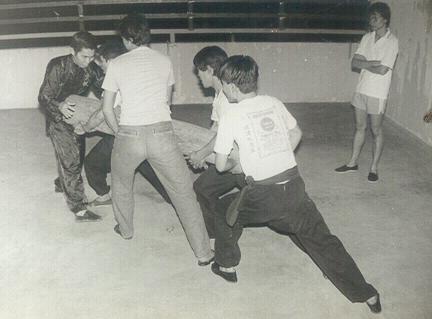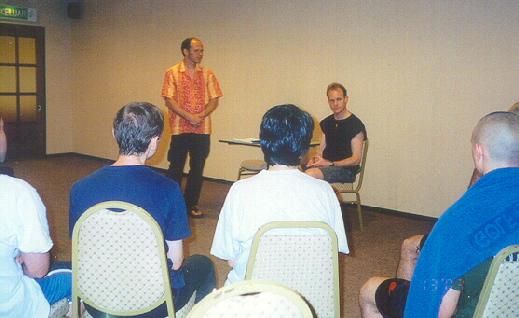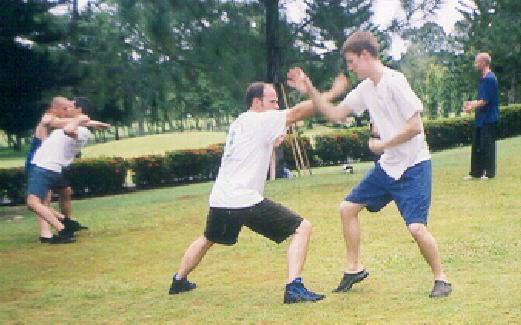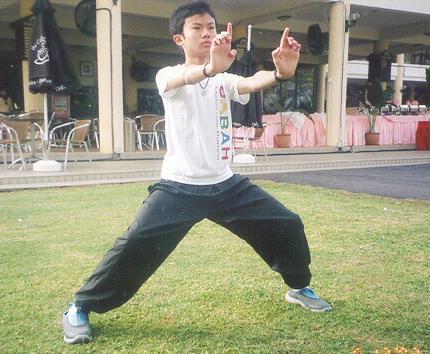February 2004 (Part 2)
SELECTION OF QUESTIONS AND ANSWERS

An old photograph showing Sifu Wong demonstrating “Golden Bell” privately to his students
Question 1
When I treat people I use my own energy. As a result the treatment drains me and this worries me and is holding me back from treating people regularly. There are also some legal issues to be resolved in Switzerland. Is there a better way to treat people using the skills I already have or am developing?
— Andrew, Switzerland
Answer
Many healers, including me, have (had? — the limitation of English grammar) this problem, especially when they first started. Overcoming this problem is one hurdle to cross in becoming a master healer. There are a few ways to overcome the problem.
One way is to use cosmic energy instead of your own energy. Here you become a medium through which cosmic energy is channeled to the patient. Reiki healers do this, though in my opinion they do not do it well. A setback is that using this method, the healer may lose much of the control over the way energy is used on the patient.
A second way is replenish yourself as soon as you can. This is a remedial approach.
A third way, which is a preventive approach, is to stop way before your feel you are approaching your limit.
Another way, which is more effective than it may appear, is to tell your subconscious mind that you will not be drained of energy. This is done in a chi kung state of mind, just before the treatment.
A fifth way is to teach the patient how to tap energy himself instead of you channeling your energy to him. This is the method I usually use now, though in my early days I used to channel quite a lot of energy into patients. If you wish to channel energy into the patient, your energy acts like a catalyse to stimulate his energy to work for himself, instead of using your energy to work for him.
In practice, of course, you use a combination of various methods above.
Question 2
Is there a way I can better protect myself from draining my own energy when helping others?
Answer
A good way is mentioned above, i.e. telling your subconscious mind that you will not drain yourself. In serious cases, you may also think of a chi shield protecting yourself and other people around.

Grandmaster Kai Uwe Jettkandt speaking to particiapants of the Special Shaolin Kungfu Course on “How Shaolin Training Can Enrich our Daily Life” in Malaysia in May 2003. Seated at the table is Master Andrew Bernett. who translated Kai's speach from German into English.
Question 3
I heard that a well known master no longer treats using his own energy and I believe that it was because he was draining his own resources too much. Do you know what method he uses and whether or not it is something I could learn?
Answer
I do not know the details, but I think you are right to believe he found his treatment methods draining on himself. I think he also uses a lot of meditation to help his patient, and this is also very draining. His approach is usually one to one, which does not make use of leverage like we do when we can teach remedial exercises to a group of people.
Personally I believe our methods are more cost-effective, especially for the healer. Ours are not draining, but his are. I would not recommend that you use his methods. Moreover, you have not been trained to do so.
Question 4
You also treat using your own energy. Why did you choose this method and where did you learn it?
Answer
As mentioned above, I used to channel a lot of energy to help patients. Although it is not our intention, this is very impressive for onlookers to watch. They witness the patient moves after seeing you channel energy into him.
As I improve my treatment methods over the years, I learn to conserve my own energy and channel less. I teach the patient to tap energy instead, such as by performing “Lifting the Sky”. This is even more impressive. At first the patient stands there motionlessly. I touch one or two of his vital points, such as bai-hui or ming-men, wave my palm at him once or twice, and he moves into vigorous chi flow.
I chose this method because it was effective in getting the patient to have a chi flow. As I found channeling chi directly to a patient draining and as I have developed better methods, I use it less and less.
I read about channelling chi in chi kung classics and observed some masters doing it. I tried that myself and it worked.
Question 5
We have various methods of developing internal force, like stances, Lohan Hands, and Sinew Metamorphosis. What other methods are there and how effective are they?
Answer
Other methods in our school include One-Finger Shooting Zen, Golden Bridge, Self-Manifested Chi Movement, Dan Tian Breathing, and Standing Zen which you know; Three-Circle Stance, Lifting Water, and Grasping Sparrow's Tail which are practiced by your Taijiquan brothers; and Cosmos Breathing, Small Universe, Big Universe, Tiger Claw, Cosmos Palm, Golden Bell, and Dragon Strength which are taught at advanced levels to disciples who are ready. These methods are extremely effective.
Other methods practiced by other schools include other forms of stance training (like the Three-Treasure Stance in Hsing Yi Kungfu and the various palm formation in Pakua Kungfu), other forms of breathing exercises (like Forceful Reversed Breathing in Northern Shaolin and Bellow Breathing in Lohan Kungfu), various forms of striking the practitioner's body (like Thirteen Grand Guards and Iron Shirt) in various styles of kungfu (including Taijiquan), and various forms of hard force training (like Iron Arm and Iron Head) in various styles of Shaolin. These arts are very effective.

Kai Uwe sparring with Michael Durkin of England during the Special Shaolin Kungfu Course in May 2003 in Malaysia. Notice the solidness of Kai's stance.
Question 6
Why do we use the methods we use?
Answer
Firstly, the force training methods we use are simple, direct and effective. We do not, for example, have to worry about carrying our training tools with us when we travel.
Secondly, I have personal experience of them. I may not be advanced in some of these arts, but at least I have practiced every one of the arts I teach to a reasonable level. This makes a lot of difference to my teaching.
Thirdly, they are comparatively safe even if students make mistakes unwittingly. The risk in Bellow Breathing, for example, would be considerably more.
Fourthly, besides enhancing our combat efficiency, our methods also enhance all aspects of our daily life. Our head may not be as hard as those with Iron Head, or our body not as tough as those with Thirteen Grand Guards, but we are probably healthier, happier and have more vitality.
Question 7
Kai has tremendous internal force but didn't concentrate much on stances in his training. Do you know what method(s) he used?
Answer
If we want to have some fun with English grammar, your statement above is grammatically and factually correct. Indeed Kai has tremendous internal force. And it is true he didn't concentrate much on stances in his training.
But if we change the two verbs in the statement into both the present tense or both the past, then the following two statements as a whole are wrong. “Kai has tremendous internal force but he doesn't concentrate much on stances in his training” is incorrect. “Kai had tremendous internal force but he didn't concentrate much on stances in his training” is also incorrect.
Before he met me about seven years ago, Kai was already very fast and powerful. In fact he was well known in competition circles to be one of the fastest kickers in the world. But his speed and power were external then. I do not know the exact training methods he used, but I guess they were similar to what many external martial artists used, like stretching and kicking sandbags.
There was, however, one big difference between his and other external martial artists' methods. Kai practiced meditation everyday (or every night). I believe this was the very factor that placed him a class above other competition fighters. Not only it gave him an edge over other fighters (Kai won 125 of his 130 competitions), but also he was (and is) very compassionate. He tried to avoid hurting his opponents as much as possible.
But since meeting me, Kai has spent a lot of time on stance training. He practiced Golden bridge and One Finger Shooting Zen everyday for many years. His speed and power have improved manifold, and are now internal. Do you notice one major change in him when you spar with him? Now he does not bounces about, but is very solid yet flexible in his stances.
When he was in China last year, he practiced “Pushing Hands” with one of the best masters there, who is informally known as the Sanda King because he has won so many sanda (or free sparring) competitions that organizers politely requested him not to take part or actually barred him from taking part. In his typical good-nature way, Kai allowed the master to push him. The master expressed amazement that Kai was so solid despite his slender figure.
Question 8
You mentioned once that you were a master of energy but Sigung Ho Fatt Nam was a master of mind. Could you please define what you meant by these terms (master of energy and master of mind)?
Answer
Although our training is holistic, i.e. we develop all our three components of “jing”, “qi” (“chi”) and “shen”, due to our differences in approaches, developmental stages and other factors, we may emphasize different aspects of our training.
My training is mainly on energy, using techniques like “Lifting the Sky”, “Golden Bridge”, “One Finger Shooting Zen”, “Sinew Metamorphosis” and “Cosmic Breathing”. Hence I become a master of energy, and I am capable of such feats where abundant energy is needed, like channeling chi, manifesting tremendous internal force, and having much vitality and stamina.
My sifu's training emphasized mind, practicing meditation most of the time. In his later years, my sifu did not sleep in bed at night. He did sitting meditation instead.
Hence he became a master of mind, and was capable of such feats where a very powerful mind was needed, and which many people might consider miracles or fakeries, such as helping people to overcome calamities by chanting mantras, exorcizing evil spirits, and even asking lesser gods to do his bidding! I seldom mentioned these abilities of my sifu because many people might think I was crazy.

Sifu Wong's youngest son, Wong Chun Yian, practicing “Golden Bridge”. This is the exercise his father asks him to practice everyday. This is also what Sifu Wong advices kungfu students to do if they wish to develop internal force, exemplifying our Shaolin Wahnam philosophy that we teach what we practice, and practice what we teach.
Question 9
I have read your book, “The Art of Shaolin Kung Fu”. It has inspired me to write to you to thank you. I have read many other books and I have two videos on Snake and Crane Forms but I know there is nothing compared to the real bond between teacher and pupil.
— Daniel, USA
Answer
I am glad you have found my book beneficial and inspiring. You will probably like my other book, “The Complete Book of Shaolin”, which you can purchase on line from my website https://shaolin.org.
You are right to say that in kungfu training there is nothing like the bond between a teacher and his pupil. Unless you are already proficient in kungfu, it is difficult, but not impossible, to learn from a book. Subtle points like how to adjust your body weight and how to exert force, need to be explained and demonstrated by a living teacher.
But if you have some kungfu foundation, a good book can be very useful. It enables you to learn from a master who may be far away from you in time and space. Often a good book also presents instructional material in a more coherent and systematic manner.
Perhaps you may attend my Intensive Shaolin Kungfu Course in future. You will be amazed at what you will learn and attain even during the course itself. Many of the things I mention in my Shaolin books will come alive.
Question 10
In Taijiquan, all of the movements must be soft and gentle (yin) in order to get the chi flowing. But we must maintain a balance between yin and yang. Shouldn't Taiji martial artists also be doing hard exercises to balance the yin? If so, which one should we perform? Or do I have my concept of yin and yang wrong?
— Ryan, South Africa
Answer
Yes, you have a wrong concept of yin and yang. Indeed most people, including many Chinese as well as many Western authors who have translated the yin-yang philosophy from Chinese texts, do not really understand what yin and yang mean! They usually mention that yin is the dark side of a mountain, female, negative, dark, retreating, soft, gentle, etc, and yang is the counterpart of these qualities. All these do not mean anything. They are just hollow words.
To have an understanding of yin and yang, there are three basic points you must know.
- Yin and yang are symbols, and as such they can refer to different things in different situations.
- No matter what they refer to, they are opposite yet complementary.
- There must be a point of reference to indicate these opposite yet complementary aspects of yin and yang, and this point of reference is usually understood implicitly, not explicitly mentioned.
Let us take some examples from Taijiquan.
When you perform Taijiquan movements, you need to be soft and gentle. Point 1, here yin refers to being soft and being gentle. Point 2, here yang refers to being hard and being rough. Point 3, the point of reference, which is not explicitly mentioned, is a comparision between Taijiquan and other martial arts like Wrestling and Kickboxing.
Suppose we change our point of reference. Instead of comparing Taijiquan with Wrestling or Kickboxing, we compare sweating out in a Taijiquan session with lying lazily in a comfortable, cozy bed. Now comparatively the Taijiquan movements would not be soft and gentle, but hard and rough. In this case, the Taijiquan movements are represented by yang, whereas lying in the cozy bed is represented by yin.
Let us come back to the notion of Taijiquan movements being soft and gentle. If we refer to these movements as yin, how do we balance them with yang? Do we have to practice hard exercises like Wrestling locks and throws? No. The yang aspect is found in the fast and powerful applications of these movements. So, here yin refers to being soft and gentle in the movements, and yang refers to being fast and powerful in their applications. Hence, if you can only perform soft, gentle Taijiquan movements, but cannot apply them fast and powerfully in combat, you have no yin-yang harmony. The point of reference here, again not explicitly mentioned, is the relationship between form and application.
Suppose you can perform Taijiquan forms beautifully and can apply them efficiently in combat, but for some reasons, you are unhealthy. Then, you do not have yin-yang harmony. Here, yin refers to good health, and yang to combat efficiency. The point of reference now is not the relationship between form and application, but the functions of Taijiquan for health and combat. In this case, can you use yin to represent combat, and yang to represent health, instead? You can, but by convention it is usual to use yin for health, and yang for combat because health is comparatively “passive” and combat comparatively “active”.
Suppose you are physically healthy and combat efficient, but you are emotionally unstable or aggressive, and you have no experience of spiritual reality. Then, you also lack yin-yang harmony. Here, yin refers to physical health and combat efficiency, whereas yang refers to emotional peace and spiritual awareness. Why is it that earlier we used yang to represent combat efficiency, and now we use yin? It is because the point of reference has changed. We are now comparing the physical with the spiritual. By convention, we use yin to refer to the physical, and yang to the spiritual.
LINKS
Selected Reading
- An Understanding and Some Experiences of Chi — Anthony Korahais
- Chi Channeling — Andrew Barnett
- The Aims and Objectives of Practicing Kungfu
- Different Ways of Moving Into an Opponent
- Questions-Answers Archive — December 2000, Parts 1, 2 and 3
